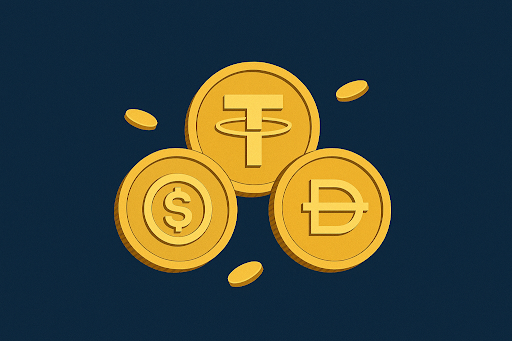Stablecoins are particularly vital for decentralised finance (DeFi) right now, especially when it comes to lending and borrowing. The cryptocurrency market is stable since it is based on stable assets like the US dollar. Stablecoins are useful for lending, borrowing, and other financial activities because their prices don't move significantly. This is different from Bitcoin and Ethereum, which can change a lot in just a few hours.
People who use stablecoins in DeFi can borrow against collateral, deposit money, and earn a constant income without having to worry about major movements in the market. Stablecoins are very crucial for cross-border transactions, reliable payouts, and making DeFi more liquid.
Models for Stablecoins
It's vital to look at how stablecoins preserve their peg in order to understand how they work in lending and borrowing. There are three primary types of stablecoins: those backed by fiat money, those backed by cryptocurrency, and those that use algorithms.
Fiat-Collateralized Stablecoins:
USDC (USD Coin) and USDT (Tether) are examples of fiat-backed stablecoins. They are backed by cash, bonds, or other traditional assets.
- The reserves that back USDC are held by U.S. financial institutions and are worth dollars. The USDC's value is based on the value of the US dollar. USDC is one of the best stablecoins to lend in DeFi because it can be redeemed, and the reports are clear. Arbitrage opportunities let traders trade tokens for real money, which raises USDC's worth again if its market price goes below $1.
- Many people utilise USDT; however, it has been attacked for not being very explicit about its reserves. People are afraid, but Tether is still the stablecoin that people trade the most. This is significant for trading pairs and the amount of money available in the cryptocurrency marketplaces.
Crypto-Collateralized Stablecoins:
MakerDAO gives out DAI, which is a decentralized alternative. Smart contracts hold Ethereum and other cryptocurrencies to aid it. To get DAI, consumers have to put up more collateral than they need, usually by 150% or more. This guarantees that the peg will stay in place even if prices drop. If the collateral loses too much value, it will automatically be sold. Even though people generally utilise DAI as collateral and not as a way to borrow money, it is vitally important to DeFi's borrowing platforms.
Algorithmic Stablecoins:
Algorithmic stablecoins don't have any physical backing; thus, they stay fixed to the dollar based on supply and demand. TerraUSD (UST) used to be an excellent example, but in May 2022, it broke down since its mint-burn process stopped working. This occurrence attracted attention to the systemic hazards of algorithmic stablecoins and highlighted once again that collateral-backed stablecoins are the most popular type of stablecoin for DeFi lending.
Also Read: How E-Commerce Stores Can Accept Stablecoins & Crypto at Checkout
Lending and Borrowing Mechanics in DeFi
Stablecoins are a big part of DeFi lending schemes. People can borrow stablecoins by putting up volatile cryptocurrency as collateral or lend them to make predictable interest on services like Aave, Compound, and MakerDAO.
The key benefit for lenders is that stablecoins give them a steady return, which is not the case with assets that change value. Stablecoin liquidity enables people to get "crypto-dollars" without having to sell their holdings. Smart contracts keep track of collateral ratios, make sure that agreements are obeyed, and carry out liquidations when they need to.
This architecture explains how stablecoins can be utilised in DeFi lending and borrowing to link blockchain-based solutions with regular financial demands.
Market Impact and Liquidity
Stablecoins have a huge impact on the DeFi markets. They made up almost 45% of all the liquidity on decentralised exchanges in 2022. Their overall market value grew from $85 billion a few months before early 2025 to $120 billion. This is increasing swiftly since both businesses and average individuals are using it.
- USDC is particularly important because it gets an average of $104 million in deposits per day. USDC is particularly important for institutional lending and borrowing, accounting for roughly 43% of all borrowing activities.
- USDT is the most traded currency because it gets an average of $34 million in deposits every day and has a borrowing utilisation rate of above 15%.
- DAI is regularly used as collateral because it gets an average of $571 million in deposits per day. Still, the interest rate on borrowing against DAI is very low at 0.04%. This suggests that its main aim is to provide liquidity, not to lend money.
These figures suggest that USDC, USDT, and DAI are still the best stablecoins for making money in DeFi. They are easy to trade, popular, and function on a lot of different platforms.
Risks and Regulatory Considerations
Stablecoins can make things work better, but they also have certain hazards.
De-pegging is a huge difficulty, as seen in the case of UST in 2022 and USDT's adjustments from time to time. Issuers may have to sell off their reserves because of a lot of redemptions that happen when people lose faith. This could affect the bigger financial markets.
Being honest is another issue. They have criticised USDC for using commercial paper and not having extensive independent audits. On the other hand, they have praised USDT for its full reserve disclosures. So, the regulations need to be explicit.
The EU's Markets in Crypto-assets (MiCA) rule is a good start. It places constraints on big stablecoins that could make the financial system less stable. People all over the world are working to make sure that stablecoins are safe before they are deployed in everyday banking systems.
Disintermediation is another risk to the system. Most deposits go into U.S. Treasuries and banks around the world. People in nations with strong inflation, like Argentina, shift their money from local banks to stablecoins like USDC. This can make it harder for banks in the area to give out loans.
Also Read: Stablecoin Regulations 2025: What Businesses Must Know
The Future of Lending with Stablecoins
There will probably be new things happening with lending and borrowing stablecoins in DeFi. Using cryptography techniques to make things more private will keep user data safe. Cross-chain loan solutions will make it simple for stablecoins to transfer from one network to another. Decentralised credit scoring will make lending more personal by improving the profiles of borrowers. You can also use tokenised real-world assets (RWAs) as collateral, like bonds or real estate. This is making it possible to create new types of hybrid lending arrangements that mix the benefits of DeFi with more traditional protections like insurance.
These tendencies will make stablecoins better at managing risk in DeFi loans, which will draw in both institutional and retail investors.
TransFi for Seamless Stablecoin Liquidity
Businesses and organisations need greater and more reliable solutions to regulate the flow of stablecoins across borders. Adding USDC, USDT, and DAI to commercial financial systems makes this process easier. TransFi has custom solutions for settling payments around the world, lending stablecoins with collateral, and lending on-chain.
Conclusion
Stablecoins are what decentralised money is built on. They make it less likely that the market will change and make it easier to borrow and lend money. Stablecoins are linked to traditional finance, have a lot of liquidity, and give you predictable returns. For instance, lending USDC in DeFi and borrowing DAI in DAI. Their part of the market is still expanding, but they need to be more open and follow more rules to deal with dangers like de-pegging and systemic consequences.
Stablecoins will keep transforming the way international banking works as new ideas like cross-chain lending, decentralised credit scoring, and using real-world collateral become more popular. Businesses that wish to take advantage of this chance can use systems like TransFi to add stablecoins to their financial operations in a safe, legal, and easy way.
FAQs:
1. What role do stablecoins play in DeFi lending and borrowing?
Stablecoins are used as collateral for bitcoin loans or placed into DeFi protocols to earn interest. They give you liquidity without any risk.
2. Which DeFi stablecoins give the most money back?
The most popular and liquid stablecoins for getting steady returns are USDC, USDT, and DAI.
3. Why do so many people in DeFi want to lend USDC?
USDC is a popular way to lend and borrow money because it is backed by institutions, regulated, and clear about what it does.
4. Is it safe to borrow against stablecoins in decentralised finance?
Yes. Some of the dangers are de-pegging, selling out collateral when the market is very volatile, and weak smart contracts. Borrowers need to make sure their collateral ratios are safe.
5. Do all DeFi platforms accept stablecoins like DAI, USDC, and USDT?
Most of the big DeFi systems let you set limitations on how much you can borrow, what interest rates you can pay, and what collateral you need. However, these rules are different for each protocol.
目次
推奨記事







.jpeg)



.png)














